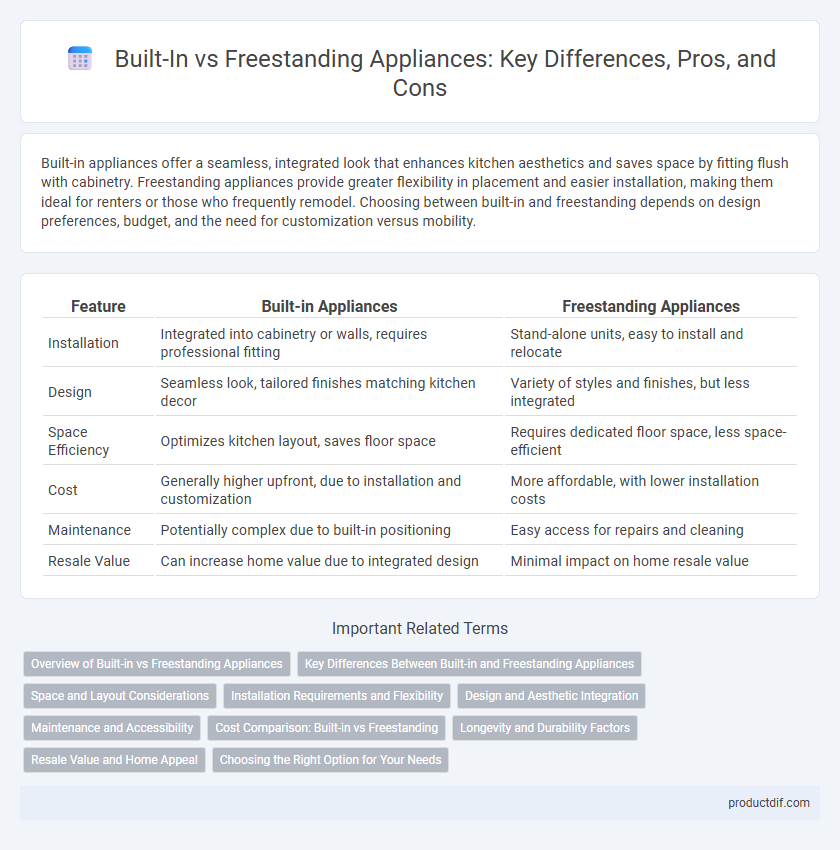Built-in appliances offer a seamless, integrated look that enhances kitchen aesthetics and saves space by fitting flush with cabinetry. Freestanding appliances provide greater flexibility in placement and easier installation, making them ideal for renters or those who frequently remodel. Choosing between built-in and freestanding depends on design preferences, budget, and the need for customization versus mobility.
Table of Comparison
| Feature | Built-in Appliances | Freestanding Appliances |
|---|---|---|
| Installation | Integrated into cabinetry or walls, requires professional fitting | Stand-alone units, easy to install and relocate |
| Design | Seamless look, tailored finishes matching kitchen decor | Variety of styles and finishes, but less integrated |
| Space Efficiency | Optimizes kitchen layout, saves floor space | Requires dedicated floor space, less space-efficient |
| Cost | Generally higher upfront, due to installation and customization | More affordable, with lower installation costs |
| Maintenance | Potentially complex due to built-in positioning | Easy access for repairs and cleaning |
| Resale Value | Can increase home value due to integrated design | Minimal impact on home resale value |
Overview of Built-in vs Freestanding Appliances
Built-in appliances are integrated into cabinetry, offering a seamless and customized kitchen design that maximizes space efficiency and aesthetic appeal. Freestanding appliances stand independently, providing flexibility in placement and easier installation or replacement without structural modifications. Choosing between built-in and freestanding appliances depends on kitchen layout, budget, and desired design integration.
Key Differences Between Built-in and Freestanding Appliances
Built-in appliances are integrated directly into kitchen cabinetry, offering a seamless, streamlined appearance and saving valuable floor space, while freestanding appliances stand alone with finished sides and can be easily moved or replaced. Built-in units typically require professional installation and are designed to match surrounding cabinetry for a cohesive look, whereas freestanding models offer greater flexibility in placement and usually come at a lower initial cost. Differences in customization, installation complexity, and aesthetic integration are key factors influencing the choice between built-in and freestanding appliances.
Space and Layout Considerations
Built-in appliances integrate seamlessly into cabinetry, saving valuable floor space and creating a streamlined kitchen layout ideal for compact or open-concept areas. Freestanding appliances offer flexibility in placement and are easier to install or replace but require additional clearance around the unit, impacting overall room flow. Choosing between built-in and freestanding depends on kitchen size, workflow preferences, and design continuity goals to optimize space utilization.
Installation Requirements and Flexibility
Built-in appliances require precise cabinetry and professional installation to ensure seamless integration and optimal functionality, limiting relocation options after setup. Freestanding appliances offer greater flexibility with minimal installation demands, allowing easier repositioning and adaptability in various kitchen layouts. Choosing between them depends on balancing permanent design aesthetics against convenience and installation complexity.
Design and Aesthetic Integration
Built-in appliances offer a seamless design that integrates directly into cabinetry, creating a streamlined and cohesive kitchen aesthetic preferred in modern and minimalist interiors. Freestanding appliances provide flexibility in placement and style, often serving as standalone statement pieces that can contrast or complement existing kitchen design. Choosing between built-in and freestanding options hinges on balancing the desire for architectural uniformity with the need for versatility in appliance arrangement.
Maintenance and Accessibility
Built-in appliances offer a streamlined look but often require professional service for maintenance due to their fixed placement, limiting accessibility to internal components. Freestanding appliances provide easier access for repairs and routine cleaning, as they can be moved independently, reducing time and effort for maintenance tasks. Choosing between built-in and freestanding depends on balancing aesthetic integration with practical accessibility for upkeep.
Cost Comparison: Built-in vs Freestanding
Built-in appliances typically have higher upfront costs due to custom cabinetry and installation requirements, often ranging 20-40% more than freestanding units. Freestanding appliances offer greater affordability and flexibility, with prices generally lower and installation simpler, making them ideal for budget-conscious homeowners. Long-term maintenance and potential resale value can also influence the overall cost-effectiveness between built-in and freestanding options.
Longevity and Durability Factors
Built-in appliances often feature a more robust integration with cabinetry, enhancing structural stability that contributes to longer lifespan and improved durability compared to freestanding models. Freestanding appliances may experience more wear and tear due to exposure and movement risks, potentially reducing their longevity over time. Material quality, installation precision, and maintenance routines equally influence the durability of both built-in and freestanding appliances.
Resale Value and Home Appeal
Built-in appliances typically enhance resale value by offering a seamless, high-end look that appeals to homebuyers seeking modern kitchens. Freestanding appliances provide flexibility and easier replacement but may not contribute as strongly to home appeal or property value. Homeowners aiming to maximize investment returns often prefer built-in units for their sleek integration and lasting aesthetic impact.
Choosing the Right Option for Your Needs
Built-in appliances offer a seamless, integrated look ideal for maximizing space and achieving a custom kitchen design, while freestanding units provide flexibility and easier installation, suitable for renters or those frequently changing layouts. Consider your kitchen size, renovation plans, and budget when deciding between built-in and freestanding options to ensure functionality and aesthetic appeal tailored to your lifestyle. Energy efficiency ratings and brand reliability also play crucial roles in making the best choice for long-term appliance performance.
Built-in vs Freestanding Infographic

 productdif.com
productdif.com